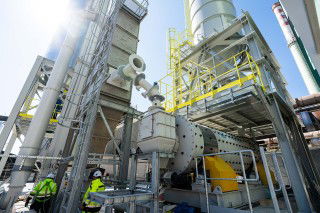This week, Sephaku Cement (Dangote group) and Holcim addressed the increasing challenge of water management and water scarcity. The issue is not just a regional one, there are mounting global pressures on water resources. Environmentalists and stakeholders are expected to increase the debate on the matter as water shortages become more acute.
The building materials sector requires water for the production of cement, aggregates and ready-mix concrete, washing gravel and sand, slurry making, cooling, vehicle cleaning, etc. Additionally, water is a primary component of concrete, representing approximately 25 per cent of the mixture. Therefore, cement companies need to put their water management strategies in place and most of them are targeting results by 2030.
Sephaku Cement (Dangote Group) recalls that, in 2016, it was projected that by 2025, more than 2.8bn people in 48 countries will face water stress or scarcity conditions and that by 2050, the number of countries facing water stress for scarcity could rise to 54, affecting 40 per cent of the world's projected 9.4bn people. So, what steps have the cement sector taken to conserve and manage water resources?
Cement majors increase efforts to manage water
This week, Holcim released its 'nature-positive strategy' that will have measurable 2030 biodiversity and water targets. Compared to its 2018 baseline, of 305l of freshwater per tonne of cementitious material produced, the Swiss multinational is striving to reduce its cement production water intensity by 33 per cent in 2030. For aggregates, Holcim is aiming for a 20 per cent reduction and for ready-mix it wants a 15 per cent fall in water intensity from its 2018 levels.
In 2021 Holcim achieved freshwater withdrawal of 273l/t of cementitious material. Currently, 23 per cent of the company's sites are in medium- to high-water risk areas, whereas it was calculated at 17 per cent in 2018. Products like Holcim's Hydromedia permeable concrete will recharge groundwater reserves as part of its ongoing initiatives to conserve water.
Meanwhile, HeidelbergCement states that it obtains some of its water resources from the public water supply but most comes from groundwater or rivers and lakes, which are heavily regulated and monitored by governments worldwide. HeidelbergCement started recording water usage in 2015 and it consumed approximately 260l/t of cement produced in 2019 and 271.9l/t of cement in 2020. HeidelbergCement states that a proportion of its 14 per cent increase in water usage, since 2018, is due to the change in its methodology. In 2020, 36 per cent of the company's sites were located in areas where water scarcity is projected by 2030. The company does not expect to introduce key data on water for all of its 2000 operational sites until 2030, by which time it aims to have water management plans for all its regions affected by water scarcity.
Similarly, Cemex has mapped more than 1500 cement, ready-mix and aggregate sites for comparison of which 51 are in water-stressed zones in its 2019 water stress map. It found it had 23 cement plants, 16 ready-mix facilities and 12 aggregate sites in water-stressed zones. Again, the company's aim is to develop a specific Water Action Plan (WAP) by 2030 for each of the mapped water-stressed locations. Cemex will implement WAP in one per cent of sites identified in extremely high water-stressed zones in 2021. Cemex states that in 2019 it used 229l/t of cement produced, 214l/m3 of ready-mix concrete produced and 100l/t of aggregates produced. In 2020 water use for cement reached 233l/t, ready-mix 219l/m3 and aggregates 123l/t for the Mexican giant. Cemex's total water withdrawal in 2020 was calculated at 53.7Mm3 and total water consumption at 37.8Mm3.
Careful water management is critical
Arguably, cement producers are not moving fast enough to head off criticism from stakeholders or environmentalists. There are examples of the cement sector coming under increased scrutiny of favouritism in receiving water supply when residents are experiencing shortages. In Kenya, for example, residents in Mombasa blocked the main highway in August 2021 to protest over water shortages for the previous three months. One protestor claimed, "Mombasa Cement has been supplying us with freshwater for months, but the firm itself was denied water from the Mazeras [Water] Station." Here the government is stepping in to build a new 22km pipeline, but the cement plant's use of water cannot be seen to be depriving paying residents of their water supply.
One of the most notable news items this year has been the case of Slite cement plant (HeidelbergCement group) whose application to renew the permit to mine limestone at the company's existing quarries in Slite, Gotland was rejected by the Supreme Land and Environmental Court in July. The quarry licence will expire on 31 October 0221 and Nordkalk will supply the Slite plant with limestone from its Klinthagen quarry on the island of Gotland, Sweden. The licence was rejected over concerns about the plant’s environmental impact assessment, particularly concerning the impact on groundwater. The court is concerned about the high levels of chloride pollution in groundwater samples taken near the site, according to Swedish news organisation Dagens PS.
Summary
Cement producers have included water management strategies in their sustainability reports for several years. Now the importance of preserving water and managing it sustainably has come to the fore. Many more announcements can be expected from the cement sector on this part of its business as the world focusses its attention on climate change. The upcoming UN's COP26 meeting in Glasgow, in November, for example, will put the topic of global water scarcity firmly in the public eye.
